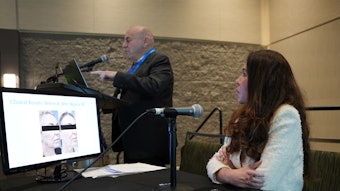Repairing autoimmune-based skin diseases is possible
New research into immune dysregulation targets Treg cells.

Evolving research in managing the role of immune dysregulation in certain skin diseases is bringing hope for the advancement of new therapeutics. The key is to restore immune tolerance by repairing flawed regulatory T (Treg) cells, for example, according to the March 9 session, U068 – Immune (Dys)Regulation in Autoimmune Skin Diseases.
The session imparted critical knowledge about Treg cell biology, immune dysregulation, and the importance of balancing immune activation and immune regulation, as well as therapeutic approaches to these kinds of immune system disorders.
“Immune dysregulation in autoimmune diseases is driven by impaired Treg function, which can be therapeutically targeted through novel immune tolerance approaches, including IL-2 therapy, microbiome interventions, and engineered Tregs, as well as from our research of novel metabolic targets,” said session director Antonios G.A. Kolios, MD, IFAAD, a dermatologist and immunologist with University Hospital Zurich in Switzerland. “These treatments shift the paradigm from broad immunosuppression to precise immune regulation.”
The power of Treg cells
Joined by speakers Johann E. Gudjonsson, MD, FAAD, and Aaron Mangold, MD, FAAD, Dr. Kolios said autoimmune diseases show an imbalance in immune activation and immune regulation, often as a result of deficiencies in regulatory Treg cell function. Therefore, immune homeostasis is crucial for preventing autoimmunity and excessive immune responses. Dr. Gudjonsson elaborated on how immunity is balanced, explaining Treg cell biology, immune homeostasis, and immune regulation.
Treg cells are central to this process by suppressing immune responses, Dr. Kolios said. Specifically, Treg cells rely on interleukin-2 (IL-2) for differentiation, survival, and function, which signals through the high-affinity IL-2 receptor (IL-2Rα–β–γ), predominantly expressed on Treg cells.
Further, Dr. Kolios said Treg cells control immune activation and autoreactive T cells as well as other immune cells via suppressive cytokines, metabolic disruption, and direct cell-contact inhibition. In autoimmune conditions, these control mechanisms or IL-2 signaling can be defective in Treg cells.
Under inflammatory conditions, Treg cells can lose function or even convert into pro-inflammatory cells (ex-Tregs) due to cytokine milieu changes (e.g., high IL-6 or TNF). In non-lymphoid tissues, Treg cells support tissue regeneration, such as in the skin, muscle, and intestines.
Knowledge gaps
One challenge in treating autoimmune skin diseases is learning to identify mechanisms of immune dysregulation as well as the role gender and race play.
He suggested taking a comparative approach. For example, illustrating the pathogenesis of systemic lupus erythematosus (SLE) versus psoriasis helps highlight the differences in autoimmune pathology.
Additional tips include learning to identify immune dysregulation via biomarkers, such as decreased Treg cell numbers, altered IL-2 signaling, and elevated pro-inflammatory cytokines. Of course, other factors, such as genetics, environment, and microbiome, also contribute to immune imbalance, he said.
Gender and racial divide
Dr. Mangold examined mechanisms of immune dysregulation, tolerance loss, and the role of gender, ethnicity, and diversity in skin autoimmunity. For example, women are disproportionately affected by autoimmune diseases (e.g., lupus, scleroderma), particularly as estrogen influences Treg cell function and enhances autoimmunity.
Likewise, according to recent studies, there is a higher prevalence and severity of autoimmune skin diseases in Black, Hispanic, and Asian individuals due to genetic and environmental factors. Dr. Kolios said these groups have higher rates of severe organ involvement.
Unfortunately, only recent clinical trials have started to represent a broader gender and racial spectrum, he said.
“Many clinical trials are Eurocentric, leading to gaps in understanding immune dysregulation in diverse populations,” he said. “Immune regulation in transgender individuals, particularly with regard to lupus, has been studied in the context of hormone replacement therapy.”
Strategies to induce immune tolerance
Despite challenges, Dr. Kolios said there are novel strategies to induce immune tolerance for immune dysregulation — both in vivo and ex vivo.
In vivo approaches include:
- Low-dose IL-2 therapy, which enhances Treg cell function in a dose-dependent manner, without activating effector T cells. Novel approaches include IL-2 muteins (engineered IL-2 with enhanced Treg selectivity), which are under development
- mTOR inhibitors (e.g., rapamycin), which shift immune balance by increasing Treg cells while suppressing effector T cell function
- Microbiome-based therapies, which can enhance Treg cell differentiation and regulate immune responses via certain gut microbiota
- Novel metabolic approaches to induce Treg cells
“When considering low-dose IL-2 in clinical autoimmune indications, most studies were completed in SLE, showing a 44-67% reduction in prednisone use and significant SLE disease activity index (SLEDAI) score improvement,” Dr. Kolios said about comparing current evidence, including data in dermatologic diseases like alopecia areata, psoriasis, and atopic dermatitis. “When considering IL-2 therapy in rheumatoid arthritis, studies show low-dose IL-2 restores Treg function and reduces disease severity in more than 60% of patients.”
Ex vivo approaches include:
- Polyclonal Treg expansion, which increases patient-derived Treg cells for reinfusion
- Antigen-specific Tregs, which use engineered Tregs to target disease-specific antigens (e.g., CAR-Tregs, CAAR-Tregs, BAR-Tregs)
“Treg cell expansion trials show promising results in type 1 diabetes and graft-versus-host disease but need further validation in skin diseases,” said Dr. Kolios.
Shooting for the immune
Looking ahead, Dr. Kolios said the goal in understanding and restoring immune regulation in autoimmune skin diseases is to transition from symptom management to immune reprogramming for long-term control or even a cure.
“As we look at the future of personalized medicine, patient selection based on gender, race, and immune profile is critical to optimize outcomes. Additionally, combining IL-2 with targeted biologicals or mTOR inhibitors might yield synergistic effects in refractory autoimmune diseases,” he said. “Autoimmune diseases are no longer a life sentence of immunosuppression. With these innovative therapies, the future of autoimmune dermatology is about immune regulation — not just suppression. Get ready for the next breakthrough!”











